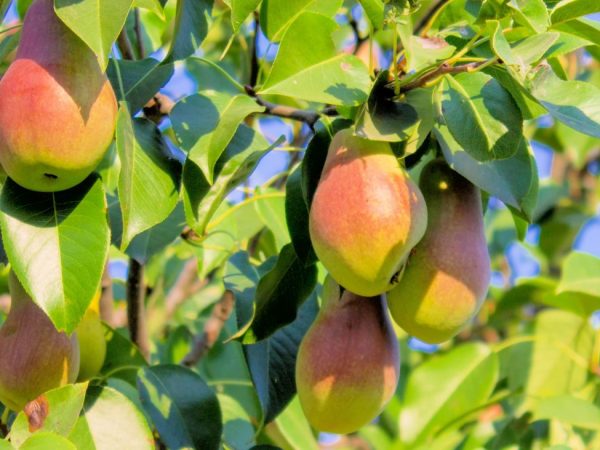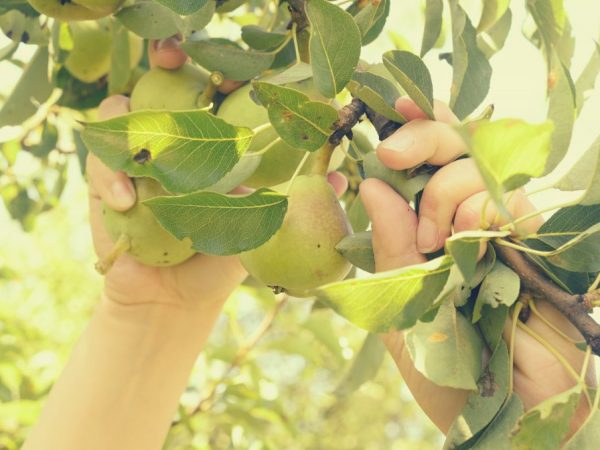Characteristics of pear varieties Perun
Pear Perun is a late variety. The fruits contain a large amount of vitamins and nutrients. This variety is easy to grow and care for, which makes it possible to get an excellent harvest without much effort.

Characteristics of pear varieties Perun
Characteristics of the variety
Trees begin to bear fruit 5-6 years after planting in the ground. The ripening period of the fruits falls on the end of October and lasts until the onset of the first frost. The yield is moderate, regular. The average yield is 17-18 kg per tree.
Pear variety Perun does not tolerate low temperatures poorly. Therefore, it is better to insulate it for the winter. But it is resistant to various fungal diseases.
The variety is self-fertile. In order for pollination to occur, it is necessary to plant other pollinating pears next to the tree, which bloom in the same period. For this, 3-4 trees are enough.
Description of the tree
The tree is of medium height - up to 7-8 m, but it can grow even higher. The bark that covers the trunk is grayish-green in color.
The crown has a very spreading crown and a rounded shape. Not prone to thickening, which is a big plus for summer residents. Therefore, you will have to cut off the regrown branches much less often.
Shoots have a smoothly rounded shape, like an arc. They are distinguished by a gray-brown color.
Leaf Description:
- dark green color;
- wide;
- egg-shaped;
- medium size.
The leaf plate is smooth, there is also a slight perceptible concavity on the leaf. The leaves have a smooth edge. Sometimes they are slightly serrated. The tree begins to bloom in late autumn, so the buds are protected from the first frost.
Description of fruits
The fruit can be harvested unripe. According to the description, technical maturity occurs by the middle or end of October. Pears can stay fresh even in winter.
Ripe fruits are greenish with a red blush.Fruit appearance:
- The fruit is medium in size, weighing 150-170 g. But there are specimens that reach 200 g.
- The fruits are traditional, pear-shaped. A feature of this fruit is its asymmetry and tuberosity.
- The skin is smooth, glossy. It is delicate and slightly oily.
- In unripe fruits, the peel is greenish. Sometimes greenish subcutaneous dots are visible. But ripe fruits are greenish with a red blush.
- Fruits are held on short, curved stalks.
- The pulp is white, buttery. There is a fine-grained consistency. The aroma is pleasant. The only drawback is that the pulp is not very juicy.
- Low sugar content in pear (13%).
The fruits can be eaten fresh. Pears of this variety are perfect for fruit slicing. You can cook compotes from them, roll up jam, prepare wine and marmalade. Drying is also made from it.
Care
Perun was bred mainly for cultivation in the Siberian regions, but despite this it can be grown in the southern regions.
Seat selection and landing
Basic requirements for the process of planting crops on the site:
- when choosing a landing site, preference should be given to a well-lit area where groundwater is at a depth of 3 m;
- strong winds and drafts must be avoided as with large drafts and winds, it can lose fruit;
- the soil must be chosen sandy loam or loamy, black soil is best;
- planting is done in the spring, and a pit 100-110 cm deep needs to be prepared in the fall
In the hole, less than half of the substrate is poured. Then they put the tree on a dais and straighten the roots. And at the end they cover it with earth. It is important that the root collar is 6 cm higher than the trunk circle.
After that, 2 buckets of warm water are poured into the hole. From above it must be covered with humus or peat crumbs.
Watering
In the first periods of growth, the plant must be watered abundantly with water. For one adult tree you need 2-3 buckets of water, for a seedling - 1 bucket. But if the weather is rainy, then the amount of watering can be halved.
After the tree has grown, watering is carried out during the flowering period. This contributes to the rapid ripening of the fruit.
Top dressing
2 years after planting, the tree needs to be fed regularly. For this in the spring, you need to apply various organic fertilizers. An excellent solution would be to use wood ash, chicken droppings, manure.
When flowering occurs, potash fertilizers are applied. When buds began to appear, phosphorus fertilizers were used. Mixing organic and mineral fertilizers will be effective.

Regular care of the variety helps to increase fruiting
Pruning and shaping the crown
Correct and timely pruning helps to increase fruiting.
Pruning is carried out in accordance with some rules:
- the first time the crown is pruned when the tree is more than 2 years old,
- any pruning must be done with a pruner;
- it is not recommended to cut off young twigs that grow from the main branch;
- the central and main pillar on young trees should be cut in half, and the adjacent branches are made in the form of a ring;
- for correct trimming, they are guided by the annular bead;
- on the main part of the tree, 5-6 main branches must be left, which must be at an angle of 45 degrees to the trunk of the pear;
- all other extra branches must be pruned by more than 25% every year;
- in order for young shoots to actively grow and develop, it is imperative to reduce once every 3-4 years not only the branches in the crown itself, but also on all surfaces of the fruit tree;
You can carry out anti-aging pruning of branches. It should start at the bottom of the tree. You need to move alternately and up.
After the end of the pruning, the ends of the branches should be treated with garden solution or oil paint. By trimming, light is available to the crown.
Pests and diseases
The Perun variety is resistant to many fungal diseases. But improper or untimely care can lead to the development of diseases.
- Gall midge is leaf. It looks like a mosquito, but much smaller, brownish in color with transparent wings. Causes great harm to freshly cut trees. They absorb all the juice, and the edges of the leaves thicken, and become like growths. To destroy these pests, it is necessary to remove the pest's nests and treat the tree with insecticides.
- Medianitsa. Pests generate a lot of sticky waste. They suck out all the moisture from the leaves. To combat sucker, it is necessary in the spring, before flowering, to treat the tree with chemicals to destroy pests and remove damaged ovaries.
- Gall mite. This individual of microscopic size lives inside the buds and on the leaves, feeds on their juice. Where this insect lives, swellings of a light shade (galls) are formed. After a while, they turn black. The leaves dry up and fall off. To fight the tick, it is necessary to spray the damaged trees with a solution of colloidal sulfur.To do this, dissolve 200 g of colloidal sulfur in 2 liters of water.
To prevent the appearance of pests, it is necessary to regularly dig up the ground around the tree. Another important event is the treatment of infected plants with insecticides:
- Golden Spark;
- Neoron;
- Regent;
- Phenaxine.
Conclusion
The Perun variety gained popularity due to its excellent yield and good consumer properties. Prized for disease resistance. The fruits can be eaten both fresh and processed.


